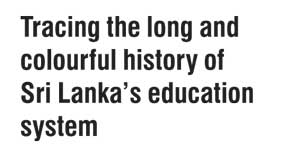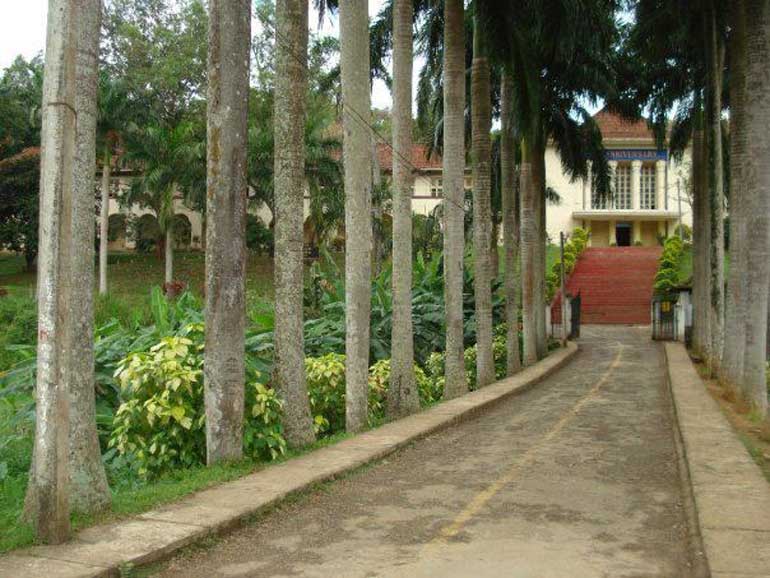Tuesday Dec 30, 2025
Tuesday Dec 30, 2025
Saturday, 12 December 2015 00:00 - - {{hitsCtrl.values.hits}}
 By D. C. Ranatunga
By D. C. Ranatunga
The news that 700 schools are to be set up to provide equal education opportunities bring new hope. The theme ‘Closest school is the Best’ echoes that hope. Is the rush for ‘the better schools’ going to end? Many will say ‘Let’s wait and see what happens’.
Every year new admissions to Grade 1 become a major talking point. So is the Year 5 scholarship examination. Both are huge issues for parents.
Looking back on our school days - what a smooth life it was! No two-mile radius rules. Anyone could sit for admission tests in the so-called elite schools in the city. All that, of course, was several decades ago. Since then population has increased, new constitutions have been promulgated, governments have changed, problems have increased.
I remember going to the ‘Sinhala iskole’, then moving over to a ‘Bilingual school’ (where English was taught) and later to Ananda College after sitting for an admission test. My shifting to Ananda coincided with Free Education when no fees need to be paid from kindergarten upwards until the end of one’s university career. Earlier, schools where English was taught charged fees.
It was not plain sailing for the ‘Father of Free Education’, Minister C W W Kannangara (1884- 1969) to push his great idea through. The veteran politician who started life as a teacher at Richmond College, Galle (where he studied) and then became a lawyer, entered politics in 1924 when he got elected to the Legislative Council from the Galle District. He later represented Galle in the first State Council (1931) and the Matugama seat in the second (1936). With the Executive Committee system in operation, he was elected to chair the Committee on Education in 1931 when he realised that the education system in the country needed a change.
Going back to early days, Sri Lanka boasts of a high level of education from as early as 4th century BC. Knowledge flourished after the introduction of Buddhism. Even after the collapse of the ancient kingdoms, the ‘pansal’ (temple) schools in the villages continued as centres of religious observances and education. The larger monasteries had ‘piriven’ schools where the novice monks were taught the Dhamma and allied subjects by scholar monks. Most of these were destroyed by the Portuguese and the Dutch in the 16th and 17th centuries. Some survived in the Kandyan areas.
Meanwhile, the Portuguese introduced schools for lay children as a means of getting them converted to Catholicism. Sinhala and Tamil were the media of instruction. The Dutch continued this system, made schooling compulsory up to 15 years and concentrated on the propagation of Dutch Reformed Christianity.
After the British took over from the Dutch, missionary schools came to be set up with the arrival of the Baptist, Wesleyan and American and Anglican Missionaries from 1812 onwards. Gradually State schools came to be established while the Missionary schools received assistance and came to be known as Grant-in-Aid Schools which were far greater in numbers than government schools.
When Minister Kannangara proposed changes to the existing system, he was met with stiff opposition from influential political leaders and from the Catholic Church. Among those who supported him were Philip Gunawardena, Dr. N. M. Perera, A. Ratnayake, D. M. Rajapaksa and Siripala Samarakkody. Among the proposals suggested by the Minister was a free mid-day meal for the school children.
Fighting his way through, Minister Kannangara got the Executive Committee on Education formed into a Special Committee and after much discussion submitted a report in 1943 which recommended radical changes. Minister Kannangara introduced the Bill on the Free Education Scheme on 30 May 1944 making a lengthy speech running to six hours. He got the support of fellow ministers S. W. R.D. Bandaranaike, George E. de Silva and Arunachalam Mahadeva. In spite of opposition by other seniors like D. S. Senanayake and J. L. Kotelawela, and with no support from the media, he succeeded in getting the Bill passed in July 1945 marking a social revolution in Sri Lanka.
The denominational schools were given the option of ceasing to charge fees and accept an increased government grant (these came to be known as Assisted Schools) or continue to charge fees with no assistance from the government. Most schools joined the government scheme.
Central schools – a success
Prior to this, Minister Kannangara initiated the establishment of Madya Maha Vidyalayas (Central Schools) in a bid to provide quality education to the rural areas. They were large and well-equipped English secondary schools which were regarded as ‘Royal Colleges’ in the provinces. There were 54 such schools by 1944. With the abolition of tuition fees in 1945 these schools became ‘one of the major avenues of advancement for the rural child’.
Positive results were soon visible when students from those schools started entering the university. Piliyandala, Tholangamuwa and Ibbagamuwa were among the pioneering ones that produced bright students who soon made their mark in the academic and administrative areas after graduation.
The credit of upgrading the University College into full university status as the University of Ceylon in 1942 also goes to Minister Kananagara.
It was ironical that in the first general election in 1947 to elect Members to the First Parliament, Minister Kannangara (UNP) was defeated by the Independent candidate Wlmot A. Perera, himself a leading educationist and founder of Sri Palee Vidyalaya, Horana. Minister Kannangara won the Agalawatta seat in the 1952 general election but was not given the Education portfolio. He was named Minister of Local Government.
Free education coupled with the student’s mother tongue as the medium of teaching in all schools helped to raise the literary levels in Sri Lanka much higher than those in the neighbouring countries. Adult literacy rate had risen to 91.8% by 2012.
Schools takeover

Another landmark event in education in Sri Lanka was the bold decision taken by Prime Minister Sirimavo Bandaranaike to take over State-aided schools. It was during the early part of her tenure after assuming office in July 1960. Analysing this action, K. M. de Silva in ‘The History of Sri Lanka’ describes it as “a policy of calculated opposition to the Roman Catholic minority over the mission schools”. He says: “on this issue, unlike the language question, the Buddhists were supported by Marxist and radical groups. All of them welcomed state control of education, the Marxists and radicals because they viewed it as a matter of social justice, and secularisation of education as an end in itself, the Buddhists because it would redress for them a long-standing grievance and eliminate what they continued to regard as the main instrument of conversion to Christianity under Western rule and the basis of Christian privilege in modern Sri Lanka.”
The 1980s saw the emergence of ‘international’ schools where teaching is in English while the ‘national’ schools are required to teach in Sinhala or Tamil. Heavy fees are charged by ‘international’ schools which train students to qualify for entry into English-medium universities abroad.
And now ‘Closest School is the Best’ which everyone will hope will be a reality soon.